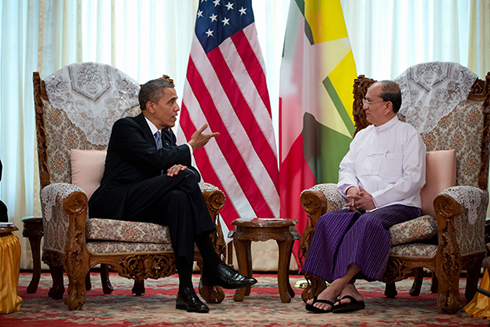
NEW DELHI – President Barack Obama’s first foreign trip since winning a second term highlights Asia’s new centrality to America’s economy and security. But Obama’s Asian tour also underscores the main question about American policy in the region: Will the United States’ “pivot” to Asia acquire concrete strategic content, or will it remain largely a rhetorical repackaging of old policies?
The United States, quick to capitalize on regional concerns triggered by China’s increasingly muscular self-assertion, has strengthened its military ties with its existing Asian allies and forged security relationships with new friends. But the heady glow of America’s return to center stage in Asia has obscured key challenges in remaining the region’s principal security anchor in the face of China’s strategic ambitions.
One challenge is the need to arrest the erosion of America’s relative power, which in turn requires comprehensive domestic renewal, including fiscal consolidation. But the need for spending cuts also raises the prospect that the US might be unable to finance a military shift toward the Asia-Pacific region – or, worse, that it will be forced to retrench there.
The US under Obama has increasingly ceded ground to China, a trend that admittedly began when the Bush administration became preoccupied with the wars in Afghanistan and Iraq. This has spurred doubts about America’s ability to provide strategic heft to its “pivot” by sustaining a higher level of commitment in the Asia-Pacific region, where it already maintains 320,000 troops. The proposed deployment of an additional 2,500 Marines in Australia is largely symbolic.
In fact, after raising Asians’ expectations of a more robust US response to China’s growing assertiveness, the Obama administration has started to tamp down the military aspects of its “pivot,” emphasizing instead greater US economic engagement. That change has come as a relief to those in the region who fear being forced to choose between the US and China. But, for the countries bearing the brunt of China’s recalcitrant approach to territorial and maritime disputes, this emphasis raises new doubts about America’s commitment.
In fact, the economic reorientation of the US “pivot” corrects a policy that had overemphasized the military component and put the US on a path toward conflict with China. It was Secretary of State Hillary Clinton who signaled a more hawkish US stance on China with her tough talk at the 2010 Association of Southeast Asian Nations (ASEAN) Regional Forum in Hanoi; now she is moderating that position by promoting trade and investment during her visits to Asian countries.
Obama, too, is highlighting the economic aspects of the US “pivot,” portraying his Asia tour as an effort to generate more domestic manufacturing jobs through higher exports to “the most rapidly growing and dynamic region in the world.” Even his historic visit to Myanmar – the first ever by a US president – is as much about trade as it is about weaning a strategically located, resource-rich country from Chinese influence.
The refocus on trade and economic issues has also prompted Washington to promote the Trans-Pacific Partnership, which aims to create a new Asia-Pacific free-trade group that excludes China. Moreover, the US is emphasizing the importance of the East Asia Summit and ASEAN, whose summit overlaps with the EAS meeting in Phnom Penh that Obama will be attending.
The US course correction is being dictated by another consideration as well: America has nothing to gain from taking sides in China’s disputes with its neighbors – unless, of course, US interests are directly at stake, as in the South China Sea, where Chinese maritime claims threaten freedom of navigation in some of the world’s most heavily trafficked shipping lanes.
Concern for its own national interest explains why America has charted a course of tacit neutrality regarding the revival of Sino-Indian territorial disputes, including China’s sudden resurrection of a claim to the large Himalayan Indian state of Arunachal Pradesh. Similarly, the US has urged both China and Japan to resolve peacefully their dispute over the Japanese-controlled Senkaku Islands. America’s main goal is to prevent the standoff from escalating to the point that it would be forced – against its own interests – to take Japan’s side.
When US Defense Secretary Leon Panetta met Chinese leader Xi Jinping in China in September, he got “an earful” that the US should stay out of the Sino-Japanese dispute. Indeed, amid the orchestrated anti-Japanese protests in China in September, Panetta – instead of advising China to rein in the often-violent demonstrations – publicly reiterated America’s neutrality in the struggle over control of the islands.
The correction in US policy actually extends even to terminology. American diplomats have now abandoned the term “pivot” altogether, owing to its military connotation, in favor of “rebalancing.”
Whatever one calls it, the new policy approach is all about China, with America bolstering alliances and friendships with countries around China’s periphery, including India, Japan, the Philippines, Vietnam, Indonesia, and South Korea. Yet the Obama administration continues to deny that China is at the center of its strategy. In fact, it is reluctant to say or do anything publicly that might raise China’s hackles.
The Asia-Pacific region will loom larger in Obama’s second-term agenda, especially as the ongoing US troop withdrawal ends the Afghanistan war by 2014. But Obama will have to define a clearer US policy, addressing China’s rapid rise under an authoritarian regime that aggressively pursues border claims and whips up nationalism at home. The US and the rest of Asia must not merely adjust to China; they must seek to shape a China that plays by the rules.
Copyright Project Syndicate
For further information on the topic, please view the following publications from our partners:
US Pivot Pitfalls and Prospects
Confusion Down Under: Australia and the US Pivot to Asia
Developments in and Obstacles to the US Pivot to Asia
For more information on issues and events that shape our world please visit the ISN’s Security Watch and Editorial Plan.

